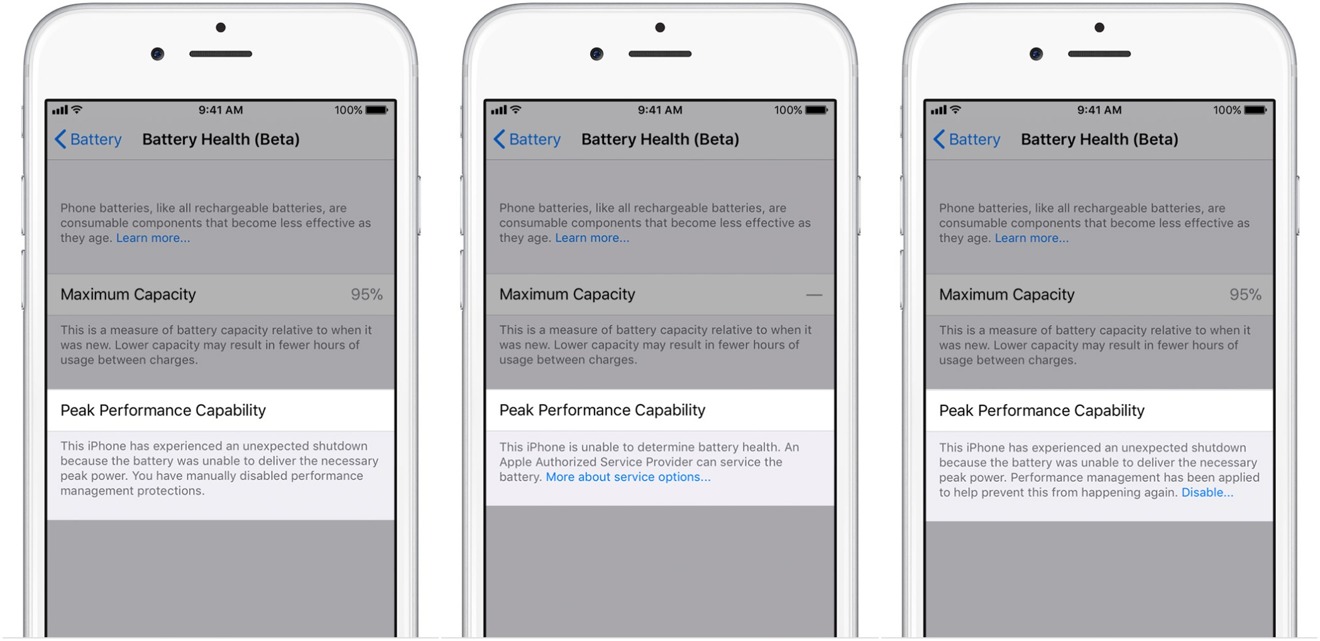Apple has published a new page about lithium ion batteries in an iPhone, discussing how they work in simple terms, why throttling is necessary, and how iPhone performance management works in iOS 11.3.
On the new page, published on Tuesday, The company leads with a discussion about how the chemical aging process in a battery affects the power that can be supplied to an iPhone. While the company didn't delve too deeply into the physics and chemistry of a battery, it explains that voltage drops are responsible for a shutdown that are "intentional from the device perspective, but "unexpected by the user."
Apple clarifies that the feature is present in nearly all devices, with the most noticeable management in the iPhone 6, iPhone 6 Plus, iPhone 6s, iPhone 6s Plus, iPhone SE, iPhone 7, and iPhone 7 Plus. The company notes that the iPhone 8, iPhone 8 Plus, and iPhone X use a more advanced design for better estimation of power needs, allowing for a different management system — making any throttling less noticeable on the new devices.
Performance management works by looking at a combination of the device temperature, battery state of charge, and battery impedance, and is only implemented if the variables require the throttling in order to prevent shutdowns.
Features of the iPhone affected by the throttling include:
- Longer app launch times
- Lower frame rates while scrolling
- Backlight dimming (which can be overridden in Control Center)
- Lower speaker volume by up to -3dB
- Gradual frame rate reductions in some apps
- During the most extreme cases, the camera flash will be disabled as visible in the camera UI
- Apps refreshing in background may require reloading upon launch
Specifically not impacted by performance management are cell quality, networking performance, photo and video quality, GPS performance, location accuracy, sensors, and Apple Pay.
Apple does remind users that batteries are consumables, and have a "limited lifespan," necessitating replacement.
Battery Health beta
The new beta has the toggle switch that Apple CEO Tim Cook promised in January, to prevent the performance management from executing. It is only selectable after the first time the phone has throttled itself because of power demands.
The first time that the phone is throttled, the iPhone will explicitly warn the user in the Battery Health settings menu.
This iPhone has experienced an unexpected shutdown because the battery was unable to deliver the necessary peak power. Performance management has been applied to help prevent this from happening again.
Once toggled off, performance management cannot be turned back on. It will be turned on again automatically if an unexpected shutdown happens while the feature is disabled, and the user will have to select it again.
However, Apple notes that "fundamental performance management" such as behavior in hot or cold temperatures, or "internal voltage management" cannot be turned off for safety and functional reasons.
The new feature warns the users is the battery health is degraded so far, that users are likely to experience "noticeable battery and performance issues." If iOS cannot determine the battery health because of a non-Apple official battery or damage, it will also warn the user that the battery should be serviced.
 Mike Wuerthele
Mike Wuerthele







-m.jpg)






 Charles Martin
Charles Martin
 Christine McKee
Christine McKee
 Wesley Hilliard
Wesley Hilliard
 Malcolm Owen
Malcolm Owen
 Andrew Orr
Andrew Orr
 William Gallagher
William Gallagher
 Sponsored Content
Sponsored Content







11 Comments
Wish they would have made this feature into a 3 position slider in Battery Settings, so the user could choose the level of throttling, like this: Performance Management: Off, Mild, Aggressive. Not letting the user turn the feature on/off but requiring the phone to have an unexpected shutdown to re-enable management is obnoxious.
I wonder where are now all the fan boys that stated this would be the most stupid idea for Apple to implement and would destroy user experience?
Thanks god for users complaining, law suits filling. Result, better UI control and experience. Well done Apple.